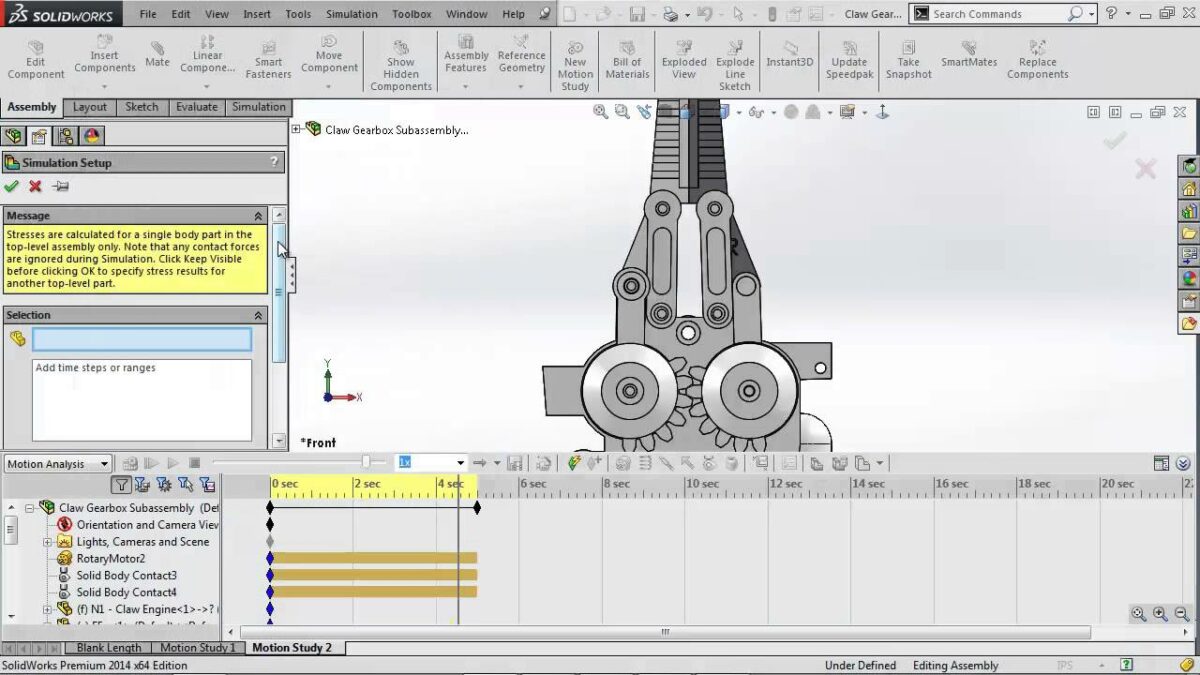Introduction: SolidWorks, a prominent computer-aided design (CAD) software, empowers engineers and designers to simulate and analyze mechanical motion within assemblies and designs. Animation is a powerful tool within SolidWorks motion studies, enabling users to visualize the dynamic behavior of components and mechanisms over time. In this comprehensive guide, we’ll explore the intricacies of animating components in motion studies in SolidWorks, covering fundamental concepts, essential techniques, and advanced strategies to help you master this crucial aspect of CAD simulation and analysis.
Understanding Animation in SolidWorks Motion Studies: Animation in SolidWorks motion studies allows users to create dynamic visualizations of mechanical motion, providing valuable insights into the behavior and performance of assemblies and components. By animating components, users can observe motion trajectories, velocities, accelerations, and interactions in real-time or at varying speeds. Before delving into the specifics of animating components, it’s essential to grasp some foundational concepts:
- Animation Timeline:
- The animation timeline in SolidWorks motion studies represents the temporal evolution of the simulation, with time progressing from left to right. Users can control the playback speed, duration, and frame rate of the animation to visualize motion behavior accurately.
- Keyframes and Interpolation:
- Keyframes are markers on the animation timeline that define specific states or positions of components at different time points. Interpolation algorithms in SolidWorks interpolate between keyframes to generate smooth motion transitions, ensuring fluid and realistic animations.
- Animation Properties:
- SolidWorks provides animation properties and controls for configuring animation settings, playback options, camera views, lighting effects, and rendering quality. Users can customize animation properties to enhance visualization clarity, realism, and aesthetic appeal.
Animating Components in SolidWorks Motion Studies: Let’s explore the essential steps for animating components in motion studies in SolidWorks:
- Activate Animation Mode:
- Begin by activating animation mode in the SolidWorks motion study environment. Navigate to the Animation tab within the MotionManager tree or use the Animation Wizard to create a new animation sequence.
- Define Keyframes:
- Define keyframes to specify component positions, orientations, and configurations at different points in time. Use SolidWorks assembly tools to manipulate components, mates, and motion controllers to achieve desired motion trajectories and behaviors.
- Set Animation Properties:
- Configure animation properties such as playback speed, duration, frame rate, and camera views to control the appearance and behavior of the animation. Adjust lighting settings, background colors, and rendering options to enhance visualization quality and realism.
- Create Motion Sequences:
- Create motion sequences by adding keyframes, interpolating motion paths, and adjusting component properties over time. SolidWorks provides tools for creating linear, circular, and spline-based motion trajectories to simulate various types of mechanical motion accurately.
- Preview and Fine-Tune Animation:
- Preview the animation sequence in real-time or using the animation timeline to visualize motion behavior and transitions. Fine-tune keyframe positions, timing, and interpolation curves to achieve smooth, natural motion and accurate representation of design dynamics.
- Add Annotations and Effects:
- Enhance the animation with annotations, labels, callouts, and visual effects to convey additional information and highlight key features or events. Use text annotations, arrows, and symbols to annotate motion behavior and provide context for viewers.
Advanced Animation Techniques: In addition to basic animation tools, SolidWorks offers advanced techniques to enhance animation creation and visualization:
- Motion Blur and Depth of Field:
- Apply motion blur and depth of field effects to animation sequences to simulate realistic motion blur and focal effects. Motion blur adds realism to fast-moving objects, while depth of field enhances depth perception and visual focus in animated scenes.
- Camera Animations:
- Create dynamic camera animations to control the viewpoint, perspective, and framing of the animation sequence. Use camera keyframes to animate camera movements, zoom levels, and angles to capture different viewpoints and perspectives of the motion behavior.
- Dynamic Assembly Exploded Views:
- Generate dynamic exploded views of assemblies within animation sequences to illustrate assembly/disassembly processes and component interactions. Use exploded view configurations, mate animations, and motion paths to animate assembly transformations dynamically.
Best Practices for Animation in SolidWorks Motion Studies: To maximize the effectiveness and impact of animation in SolidWorks motion studies, consider the following best practices:
- Plan Animation Sequences:
- Plan animation sequences and objectives in advance, identifying key components, motions, and events to animate. Establish clear goals and storytelling elements to guide animation creation and ensure alignment with design objectives.
- Simplify and Focus:
- Simplify animation sequences by focusing on essential components, motions, and interactions to avoid clutter and maintain viewer attention. Emphasize critical design features and behaviors while minimizing extraneous details and distractions.
- Iterative Refinement:
- Iterate and refine animation sequences based on feedback, review, and validation from stakeholders. Fine-tune keyframe positions, timing, and visual effects iteratively to achieve desired animation quality, realism, and storytelling effectiveness.
- Collaborate and Communicate:
- Collaborate with design team members, stakeholders, and clients to review and iterate on animation sequences collaboratively. Use animation as a communication tool to convey design intent, functionality, and performance effectively to diverse audiences.
Conclusion: Animation in SolidWorks motion studies is a powerful tool for visualizing, analyzing, and communicating mechanical motion within assemblies and designs. By mastering the techniques and principles of animation creation, you can enhance your design process, validate design performance, and communicate design intent effectively to stakeholders. Whether you’re a novice or an experienced SolidWorks user, understanding the fundamentals of animation and adhering to best practices will elevate your CAD skills and enable you to create compelling, informative, and visually engaging animations efficiently.
